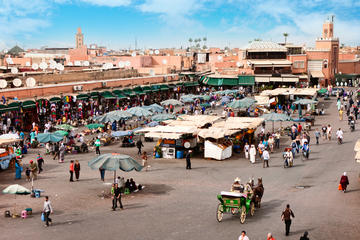
Medina of Marrakesh
Marrakesh, once the most powerful commercial and political center in the Arab world, was founded in 1062 by Berber chieftain Abu Bakr ibn Umar as the capital of the orthodox-Muslim Almoravid Empire. Full of ornate monuments built mostly between the 12th and 16th centuries, a visit to its medina, or old town, is like a walk through a heavily fortified open-air museum. It was listed as a World Heritage Site in 1985.
Surrounded by ancient walls and enormous gates, the medina contains a huge central courtyard called the Jemaa el-Fnaa, a center of trade and public gatherings since Morocco’s inception. The medina is also home to a series of stunning gardens, including the Majorelle Garden, set beside the Museum of Islamic Art and featuring plants collected from five continents.
The lavish Royal Palace and Badi Palace stand adjacent to one another, but neither are open to the public; to get a look inside royal life in the medina, albeit a late 19th-century interpretation, visit the nearby Bahia Palace and its two-acre courtyard garden.
The heavily ornamented Koutoubia Mosque, set in the medina’s southwest corner, has a distinctive 253-foot-high minaret surrounded by a garden plaza. The nearby Ben Youssef Mosque was originally the oldest in the city, but fell into ruin and was rebuilt in the 19th century; its green-tiled roof can be seen from all over the medina. The Mousassine Mosque, built in the 14th century, is a sprawling complex of buildings highlighted by the enormous triple-arched Mousassine Fountain, inscribed with elaborate scrollwork and calligraphy.
The 16th-century Saadian Tombs, in which many of the most prominent members of Morocco’s 15th and 16th-century sultanate Saadi tribe are interred, feature ornate arches with carved scrollwork. A popular pilgrimage site, the Seven Saints Tombs contain the bodies of the seven patron saints of Morocco.
Near the Kasbah (where Morocco’s leaders were kept safe in the city’s early days), the mellah, or ancient Jewish quarter is the most condensed section of the city. Now a Muslim neighborhood, remnants of the past include the Alzama Synagogue and the largest Jewish cemetery in Morocco.
